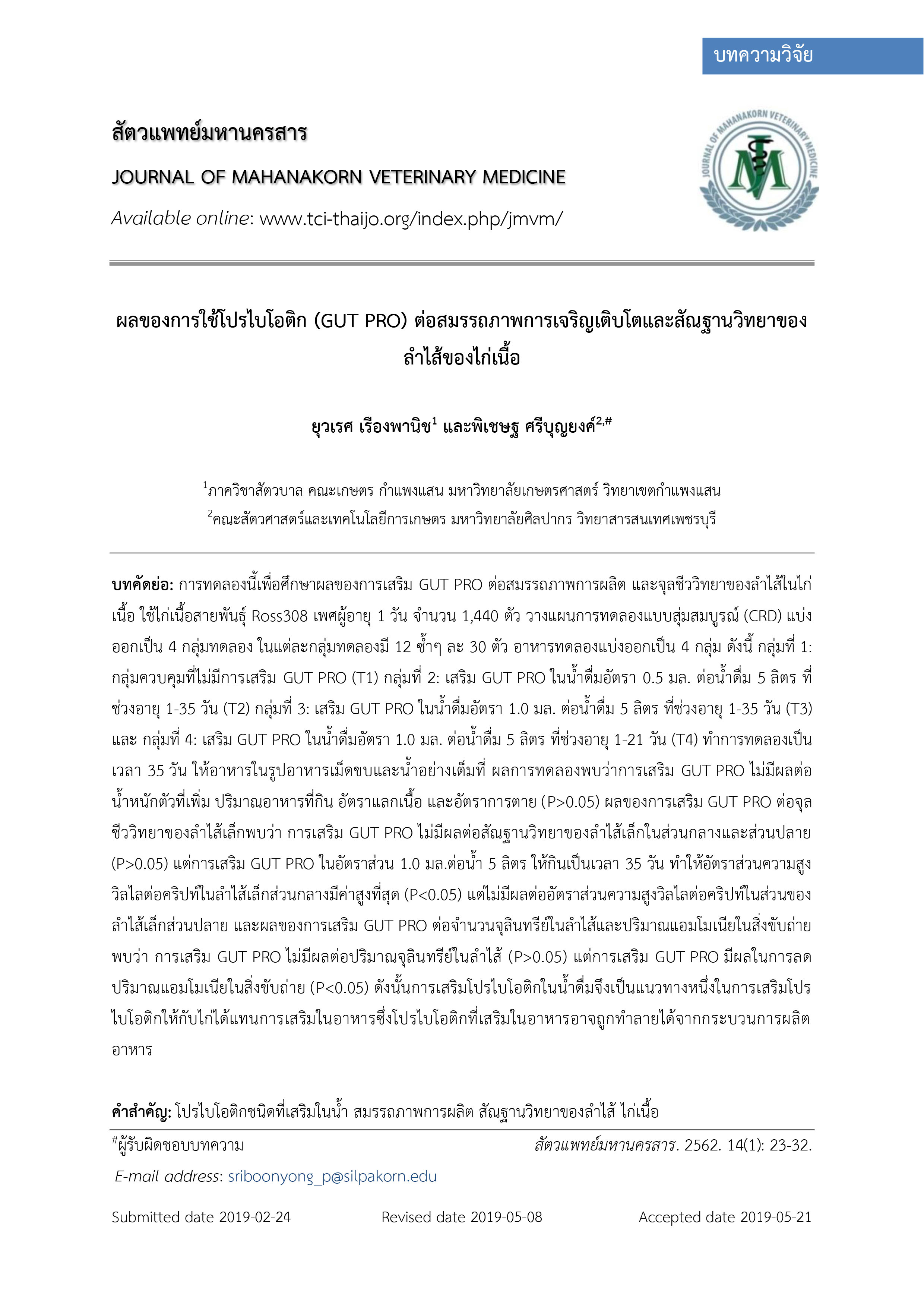Effect of Using Probiotic (GUT PRO) on Growth Performance and Gut Morphology in Broiler
Main Article Content
Abstract
This study was conducted to investigate the effect of GUT PRO on growth performance and gut histology of broiler. One thousand, four hundred and forty day old Ross 308 were randomly allotted into 4 groups of 12 replications, each replication containing 30 birds. The experimental diets were divided into 4 groups as following T1: Control group (without supplemented GUT PRO), T2: Supplemented GUT PRO 0.5 ml/5.0 L in drinking water at 1-35 DOA, T3: Supplemented GUT PRO 1.0 ml/5.0 L in drinking water at 1-35 DOA and T2: Supplemented GUT PRO 1.0 ml/5.0 L in drinking water at 1-21 DOA. The trial was run between 1 and 35 days of age.Feed in crumbled pellet form and water were provided Ad-libitum throughout the experiment. The results revealed that feeding GUT PRO had no significant difference in body weight gain, feed intake, FCR and mortality rate among dietary treatments (P>0.05). The effect of feeding GUT PRO on gut histology shown that supplemented GUT PRO had no significant difference on gut morphology (P>0.05) in jejunum and ilium. Supplementation GUT PRO 1.0 ml/ 5 l of drinking water for 35 day of age increased villus height/crypt depth ratio in jejunum but had no significant difference in Ilium (P>0.05). The effect of feeding GUT PRO on intestinal bacterial counts and NH3 in excreta are shown that there was no significant difference in intestinal bacterial counts among dietary treatments (P>0.05). Feeding no probiotic in water had negative effect on ammonia content in excreta (P<0.05). Supplementation of probiotic in drinking water is an alternative way to supplement probiotic for broiler because supplementation probiotic in feed may destroyed in feed processing.
Article Details
References
Hartke, J. L., M. H. Monaco, M. B. Wheeller and S. M. Donovan. 2005. Effect of a short-term fast on intestinal disaccharidase activity and villus morohology of piglet suckling insulin-like growth factor-I transgenic sows. Journal of Animal Science. 83(10):2404-2413.
Hatairat, M. 2008. Screening of lactic acid bacteria as probiotics in chicken and enhancement of bacteria survival by microencapsulation. MS Thesis, Prince of Songkla University, Songkla. (in Thai)
Hedemann, M. S., M. Eskildsen, H. N. Laerke, C. Pedersen, J. E. Lindberg, P. Laurinen and K. E. Knudsen. 2006. Intestinal morphology and enzymatic activity in newly weaned pigs fed contrasting fiber concentrations and fiber properties. Journal of Animal Science. 84(6):1375-1386.
Jacob, M. B. 1960. The chemical analysis of air pollutants. New York, USA: Interscience Publishers Inc, p. 43.
Lilian, F.A. de Souzaa, N. A. Denise, M. S. Lenita, C. G. Ines, C. C. Valquíria, P. Gustavo and F. B. Maria. 2018. Probiotics on performance, intestinal morphology and carcass characteristics of broiler chickens raised with lower or higher environmental challenge. Austral J Vet Sci.50:35-41.
Murry, A. C. Jr., A. Hilton, Jr. and R. J. Buhr. 2006. Effect of botanical probiotic containing Lactobacilli on growth performance and populations of bacteria in the ceca, cloaca, and carcass rinse of broiler chickens. Inter. J. Pault. Sci. 5(4):344-350.
Nopparatmaitree, M., W. Kitpipit, J. Sri-onlerd, S. Prajukboonjatsada, C. Phuengpathomphorn, S. Mongphuank, E. Kamonlapworakul and S. Khianngam. 2017. The effects of multi-strain Bacillus species supplementation in drinking water of broilers on performance, carcass characteristics, meat quality, cholesterol and fatty acid in meat. J. Sci. Technol MSU 37(2):191-201. (in Thai)
Pascual, M., H. Marta, I. B. Jose, M. M. Josep and G. Magarita. 1999. Lactobacillus salivarius CTC2197 Prevents Salmonella enteritidis Colonization in Chickens. Applied and Environmental Microbiology. Nov.:4981–4986.
R Core Team. 2016. R: A language and environment for statistical computing. R. Foundation for Statistical Computing, Vienna, Austria. URL https://www.R-project.org/
Saenmahayak, B., S. Bureenok and K. Ampaporn. 2014. Efect of lactic acid bacteria as probiotic on broiler carcass quality. Khon Kaen Agr. J. 42(Suppl. 1): 307-311. (in Thai)
Saguanpan, S., P. Ak-Karamathurakul and N. Paraksa. 2017. Study of the inhibitory efficiency of probiotic (Bacillus subtilis) on intestinal pathogenic bacteria and affecting on productive performances of broilers. Khon Kaen Agr. J. 45(2): 255-262. (in Thai)
Sakamoto, K., H. Hirose, A. Onizuka, M. Hayashi, N. Futamura, Y. Kawamura and T. Ezaki. 2000. Quantitative study of changes in intestinal morphology and mucus gel on total parenteral nutrition in rats. J Surg Res. 94(2):99-106.
Vimon, S. 2014. Effecys of Bacillus subtilis and Bacillus licheniformis supplementation on growth performance, nutrient digestibility, cecal microbiota and small intestinal morphology in broilers. MS Thesis, Chulalongkorn University, Bangkok. (in Thai)
Zhang, Z. F. and I. H. Kim. 2013. Effects of probiotic supplementation in different energy and nutrient density diets on performance, egg quality, excreta microflora, excreta noxious gas emission, and serum cholesterol concentrations in laying hens. J. Anim. Sci. 91:4781–4787.


